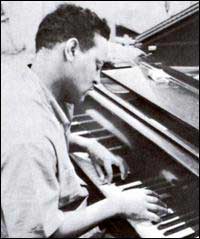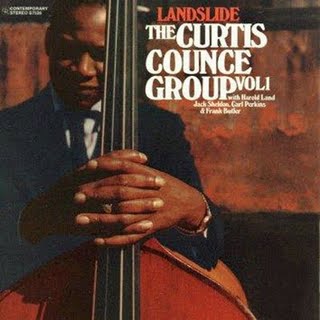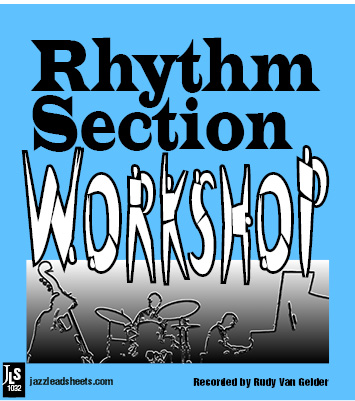Mia – Carl Perkins
A clever composition with complex rhythmic figures and a delightful melody. Lead sheets and second parts available. Plus a Rhythm Section Workshop version with Minus You tracks for piano, bass, and drums to play along with, in two different tempos.
- Recording: Curtis Counce - Landslide
- Recorded on: October 8, 1956
- Label: Contemporary (C 3526)
- Concert Key: D-flat
- Vocal Range: , to
- Style: Swing (uptempo)
- Trumpet - Jack Sheldon
- Tenor Sax - Harold Land
- Piano - Carl Perkins
- Bass - Curtis Counce
- Drums - Frank Butler
Video
- Description
- Historical Notes
- Solos
- Piano Corner
- Bass Corner
- Drum Corner
- Guitar Corner
- Inside & Beyond
- Minus You
Click on the second album cover for our exclusive Rhythm Section Workshop, a trio recording with Minus You tracks for piano, bass, and drums.
For more information about recordings of Carl Perkins, check out Noal Cohen's Jazz History website.
Michael Cochrane's one-chorus voicings explore several different paths through the changes of the A section. A1 consists of five-note voicings with the top note doubled an octave lower throughout; these also lack the roots. A2 moves between four-, five- and six-note structures largely containing roots. The texture at B is similar to A1 but with occasional roots and not always using octave doubling. C is a variation of A1 with a few different upper structures.
These footballs show one way Michael hears the solo chord progression move from chord to chord. When studying them, your concentration can be focused solely on the chord progression and how chords move from one to another. Rhythmically, it's simple whole notes and half notes, or the basic harmonic rhythm of the chord progression of the solo section. The footballs are also annotated, showing the original chord symbol above the voicing, as well as any extensions below the voicing. The idea is that these voicings could be of varied uses to any level of pianist—a beginner pianist could play the music exactly as on the page and provide a supportive and harmonically hip sounding accompaniment to a soloist, while a more advanced pianist could use these same voicings with varied rhythms in the style of the recording. Ultimately, a pianist would be able to absorb how these voicings were derived from the chord symbols, and then be able to create their own.
Mia is an energetic uptempo tune for anyone who wants a challenge. The syncopation of the bass part will keep every bassist on their toes. The band on the original recording is well-rehearsed, making it extra fun to try to lock up with them while playing along. Although the bass part stays in the meat of the instrument, the tune is in the key of D-flat, adding an additional hurdle.
Related Songs
Email Send Mia to a friend
- Recording: SFM Trio - Rhythm Section Workshop
- Recorded on: July 9, 2014
- Label: jazzleadsheets.com (JLS 1032)
- Concert Key: D-flat
- Vocal Range: , to
- Style: Swing (medium up)
- Piano - Glenn Zaleski
- Bass - Bill Moring
- Drums - Evan Hughes
Video
- Description
- Historical Notes
- Solos
- Piano Corner
- Bass Corner
- Drum Corner
- Guitar Corner
- Inside & Beyond
- Minus You
There are also Minus You tracks (labeled slower) at a slower tempo, great for less experienced musicians. Click on the Minus You tab for short audio clips.
For a few years the great team of pianist Glenn Zaleski and drummer Evan Hughes worked with jazzleadsheets.com, creating transcriptions, lead sheets, videos and recordings for our catalog. For this project they were joined by bassist Bill Moring.
clip The format is:
-- intro
-- melody
-- piano solo 2 choruses
-- bass solo 2 choruses
-- piano and drums trading 4s two choruses
-- out melody
clip The slower version has the in melody, a two-chorus piano solo, and the out melody.
mp3 minus Piano
-- count off sets up the intro
-- play the intro and melody
-- solo 2 choruses
-- comp for the bass solo 2 choruses
-- trade 4s with drums 2 choruses
-- play the out melody
clip The slower version has the in melody, a two-chorus piano solo, and the out melody.
mp3 minus Bass
-- count off sets up the intro
-- play figures/walk for the intro and melody
-- walk for the piano solo 2 choruses
-- solo 2 choruses
-- walk for piano trading 4s with drums 2 choruses
-- play figures/walk for the out melody
clip The slower has the in melody, a two-chorus piano solo, and the out melody.
clip minus Drums - sticks throughout, snaps have been added for the trading sections
-- count off sets up the intro
-- play figures/comp for the intro and melody
-- comp for the piano solo 2 choruses
-- comp for the bass solo 2 choruses
-- trade 4s with piano 2 choruses (piano first)
-- play figures/comp for the out melody
clip The slower version has the in melody, a two-chorus piano solo, and the out melody.br />
Related Songs
Email Send Mia to a friend

Carl Perkins
August 16, 1928 – March 18, 1958
Do not confuse this Carl Perkins with the rockabilly guitarist with the same name. This Carl Perkins was an exceptional pianist who developed a unique style of playing the piano with an inimitable left-hand technique. Not much is known about him, despite the fact that one of his compositions, Grooveyard, went on to become rather famous. Born in Indianapolis, IN, he worked with Tiny Bradshaw and Big Jay McNeely (1948-1949) there, then moved to Los Angeles, CA, in 1949. He did his first recording session (his own date) that year in Los Angeles for Savoy Records. Read more...


